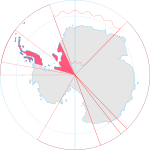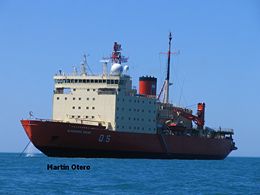Argentine Antarctica
|
|||||
| Motto: En Unión y Libertad | |||||
| Anthem: Argentine National Anthem | |||||
 |
|||||
| Status | Department of the Tierra del Fuego, Antártida e Islas del Atlántico Sur Province | ||||
| Official language(s) | Spanish | ||||
| Capital | None | ||||
| Area | 965.597 km² | ||||
| Population | 165 (winter)-300 (summer) | ||||
| Currency | Argentine Peso | ||||
Argentine Antarctica (Spanish: Antártida Argentina) is a sector of Antarctica claimed by Argentina as part of its national territory. The Argentine Antarctic region, consisting of the Antarctic Peninsula and a triangular section extending to the South Pole, is delimited by the meridians 25° West and 74° West and the parallel 60° South latitude. Administratively, Argentine Antarctica is a department of the province of Tierra del Fuego, Antarctica, and South Atlantic Islands. The provincial authorities reside in Ushuaia and the Governor annually designates his or her delegate for the Antarctica region, which thus represents the civil power of the zone. There are overlapping claims on this territory by Chile and the UK, so the "civil power" of any of the administrators extends no further than that nation's own bases.

The Argentine exploration to the continent started early in the 20th century. José María Sobral was the first Argentine to set foot on Antarctica in 1901, where he spent 2 seasons with the Swedish Antarctic Expedition of Doctor Otto Nordenskiöld. Shortly afterwards, in 1904, the Orcadas permanent base was already fully operational. Years later other bases would be created, some permanent and others seasonal. The first Argentine expedition to reach the South Pole was the 1965 Operación 90.
Contents |
Argentine bases
Esperanza and Marambio are the biggest Argentine bases, holding together 70 buildings, an average of 110 persons during the winter, and over a maximum of 250 during the summer. Orcadas Base, located at the South Orkney Islands off of the Antarctic mainland (see map, right), was the world's first base in the Antarctic region, operating continuously since 1903. The southernmost Argentine permanent base is Belgrano II, at over 77 degrees south. The southernmost summer base is Sobral, at 1,450 kilometres far from Belgrano II.
The bases are supplied by the following ships: Puerto Deseado, Suboficial Castillo, and Almirante Irizar, and by C-130 Hercules and DHC-6 Twin Otter aircraft.
Permanent

- Belgrano II, () Laboratory and meteorological station Argentine southernmost base (since 1979).
- Esperanza () Laboratory and meteorological station (since 1952). Radio LRA Arcángel, School #38 Julio A. Roca (since 1978), tourist facilities.
- Jubany, () Scientific station at King George Island
- Marambio Base Station, () Seymour-Marambio Island. Laboratory, meteorological station, 1.2km long, 30m wide landing track (since 1969) (website)
- Orcadas Base () Orcadas Islands (since 1903)
- San Martín Base () (since 1951) Laboratory and Meteorological measurements
Seasonal

- Teniente Camara Base (1957) , Livingstone Island
- Base Deception (1948) , Deception Island
- Petrel Air Station (1967) Dundee Island
- Primavera Base (1977) , Alejandrina Island
- Des. Navy Melchior Base(1947 Anvers Island
- Almirante Brown Base(1951) , Paradise Bay
- Teniente Matienzo Base (1961) , Nunatak Larsen
Camps and other
(64 in all)
- Base Alférez de Navío Sobral (1965) , Edith Ronne Land
- Campamento Byers , Byers peninsula
- Estación Científica Ellsworth (ex USA) (1958) , Weddell Sea
- Base Gurruchaga , Nelson Island
- Campamento Científico Livingston , Livingston Island
Argentine claim


According to historical claims, the Argentine presence in the section began during the first decade of the 19th century; though some even affirm that it took place by the end of the previous century. However, navigators from other countries claimed the discovery of Antarctica for themselves. By the end of the 19th century the aid lent by Argentina to foreign expeditions, in particular that of Nordenskiöld, Gerlache and Charcot, was properly appreciated. This included the assignment of Argentine place names to Antarctic geographic features, such as the Argentine Islands, Uruguay Islands, General Roca, Quintana, and others.
In 1904 the permanent occupation began with the opening of Orcadas Base on Laurie Island just off the Antarctic mainland. Argentina was the only nation to have an Antarctic base for 40 years until the British built a base on the same islands.
Argentina bases its claims on this sector of Antarctica on the following grounds:
- The Antarctic peninsula is geologically and geographically part of the Andes.
- Argentina has maintained a permanent occupation for more than a century, and controls the oldest base in Antarctica (Orcadas Station on Laurie Island).
- Argentina conducts many rescue missions in Antarctica.
- Argentina has constructed lighthouses and other navigational aids in Antarctica.
- Argentina constructed Antarctica's first airport in 1969
- Argentines form more of Antarctica's peninsula's population than nationals of any other country.
- The first Antarctican was born in Esperanza Base (Hope Base), namely Emilio Palma.
- Argentina has sent more people to Antarctica than all the other countries together.
Argentina's claim to the Antarctic Peninsula overlaps with the Antarctic claims of Chile, 53°W to 90°W, and the UK claims, 20°W to 80°W, and is not recognized by most other countries. See List of Antarctic territorial claims.
Currently, there are no attempts by Argentina or any other country to actually enforce territorial claims in Antarctica.
Demographics
In 1978, the first Antarctic baby was born in the Fortín Sargento Cabral at the Esperanza Base under the name Emilio Palma. In 1991 there were 142 "permanent residents" including 19 minors. "Residents" are families that live in Antarctica or scientists that have lived for more than two years. They were 121 men and 21 women that lived mostly in the colony of Esperanza and other bases. As of 1998-1999, Argentine Antarctica had a winter population of 165.
- See also: Demographics of Antarctica
See also
| Regions of |
|---|
| Argentine Northwest |
| Gran Chaco |
| Mesopotamia |
| Cuyo |
| Pampas |
| Patagonia |
| Antártida Argentina |
- Argentine actions in Antarctica
- Antarctica
- Tierra del Fuego Province (Argentina)
- Antártica and Magallanes and Antártica Chilena Region
- British Antarctic Territory
- Antarctic Treaty System
- List of Antarctic territorial claims
External links
- Argentine Bases
- Marambio Base (Spanish/English)
- Dirección Nacional del Antártico: Bases
- Argentine Antarctica History (Spanish)
|
|||||||||||||
|
|||||


